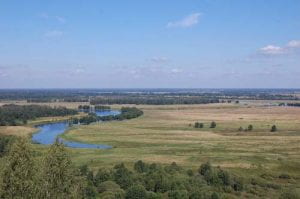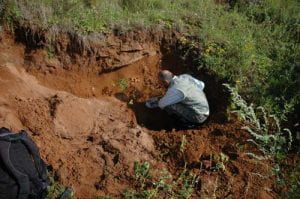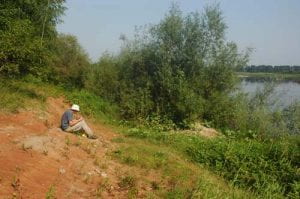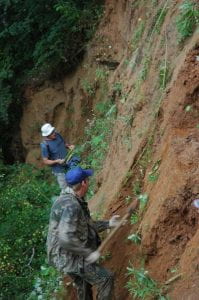Narrative of the 2008 Expedition
The 2008 Expedition was a short trip in August 2008 to explore two classic Permo-Triassic redbed successions in the wider Moscow Basin, Vyazniki and the Vetluga. This time, the UK contingent was just Andy Newell and Mike Benton, and on the Russian side Andrey Sennikov, Alexey Kurkin, and Valery Golubev in Vyazniki, and Valentin Tverdokhlebov and Iya Molostovksaya on the banks of the mighty Vetluga.
Vyazniki
The city of Vyazniki, founded in 1778, is 300 km directly east of Moscow. The city dates back to the twelfth century when the fortress Yaropolch was established to help defend the religious city of Vladimir to the west. Vladimir had been founded at least by 1108, when the first of many cathedrals, monasteries, and convents was established. Through the middle ages, the fledgling Russian state was attacked repeatedly by the Mongol-Tatar hordes, who succeeded in destroying the Yaropolch fortress and Vladimir. In the nineteenth century, Vyazniki was famous for its linen industry.Vyazniki stands on Permo-Triassic rock, and the outcrops extend 20 km east of the city to Gorokhovets. The Vyazniki red beds are historically important because Roderick Impey Murchison first identified continental Permian in Russia here in 1841, but the precise age of the succession, the sediments, and the fossils have been debated ever since. More significant, although uppermost Permian sediments are well documented in the region, the Permo-Triassic boundary so far has not been identified definitively.
Roderick Impey Murchison (1792-1871) and his colleague, French palaeontologist Edouard de Verneuil (1805-1873) visited Vyazniki in 1841, and they reported the first evidence of continental Permian, indeed of any Permian, in Russia from that location. They noted variegated clays and sands at Tolmachevo, now a noted viewpoint over the Klyaz’ma River, and identified bivalves and ostracodes of Triassic/ pre-Triassic appearance. This was Murchison’s second visit to Russia, undertaken with the aim of documenting the geology of European Russia and the Urals, but also to seek to fill the gap between the well-defined Carboniferous and Triassic rocks of western Europe (Benton 2003). This identification of Permian beds at Vyazniki pre-dated Murchison’s subsequent visit to Perm and the western slopes of the Urals, later in 1841, during which he definitively identified marine Lower Permian, and so felt confident in marking the base of the missing system, which he named the Permian (Murchison 1841). Read further historical details here.
Not much more was published on these rocks until 1951, when a local collector discovered vertebrate fossils at the western end of the Vyazniki town area. He contacted palaeontologists at the Palaeontological Institute of the Academy of Sciences of the USSR (PIN) in Moscow, and a team led by B. P. V’yushkov carried out excavations in 1952, 1955, and 1956 (Efremov and V’yushkov 1955). Finds in the 1950s included a variety of fishes, amphibians, and reptiles, mostly occurring as isolated bones in conglomerates and coarse sandstones, but with occasional more complete remains, such as the complete skulls of the temnospondyl Dvinosaurus and the therocephalian Moschowaitsia.
This tetrapod assemblage, representing an apparent mix of latest Permian and earliest Triassic elements, led to the suggestion (Sennikov and Golubev 2006) that the Vyazniki beds might represent the very youngest Permian anywhere in the Russian basins, and the unit has even been made the type of a new terminalmost Permian stratigraphic stage (Lozovskiy and Kukhtinov, 2007).
New work on sedimentology and stratigraphy
We worked at 12 localities around the city of Vyazniki, and east to the Zhukov Ravine, near Gorokhovets. There is a definitive PTB section in the Zhukov Ravine, as yet unpublished, but identified by the occurrence of age-diagnostic ostracodes below and above the boundary. Lateral correlation between sections, using lithological and biostratigraphic markers should enable us to identify the sedimentary settings of the Permo-Triassic successions, and whether there is alo a PTB in the Vyazniki locations. We have nowm published a detailed account of the stratigraphy and sedimentology of the Vyukov Ravine and Vyazniki PTB sections (Newell et al. 2010), and an historical account of Murchison’s first sighting of the Permian here (Benton et al. 2010).
On the banks of the mighty Vetluga
The Vetluga River flows into the left side of the Volga, and the portion of the river close to Voskresensokoye exposes a series of sections on its western side that document much of the classic Lower Triassic red bed succession. Indeed, the section gave rise to the formal term Vetlugian Supergorizont for most of the Early Triassic, including the Vokhmian, Rybinskian, Sludkian, and Ust-Mylian gorizonts (Tverdokhlebov et al. 2003). The Vetlugian spans the international Induan, and most of the overlying Olenekian, stages.
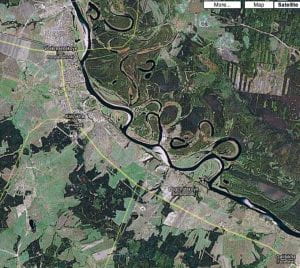 Google map of the Vetluga River at Voskresenskoye and south to Galibikha, showing remarkable sets of ox bows as the river meanders change course. Good exposures of Triassic red beds occur on the west bank of the river, where the water course swings in to hit the bank.
Google map of the Vetluga River at Voskresenskoye and south to Galibikha, showing remarkable sets of ox bows as the river meanders change course. Good exposures of Triassic red beds occur on the west bank of the river, where the water course swings in to hit the bank.
Our aim for this part of the trip was to visit as many locations as we could, to log through these, and attempt to identify major sedimentary features. Ostracodes and other fossils provide good biostratigraphic control. We shall add more as the data are processed.
References
- Benton, M.J. 2003. When life nearly died: the greatest mass extinction of all time. Thames & Hudson, London.
- Benton, M.J., Sennikov, A.G., and Newell, A.J. 2010. Murchison’s first sighting of the Permian, at Vyazniki in 1841. Proceedings of the Geologists’ Association 121, in press (doi:10.1016/j.pgeola.2010.03.005). pdf.
- Efremov, I.A. and V’yushkov, B.P. 1955. [Catalogue of the Permian terrestrial vertebrates from the territory of the USSR.] Trudy Paleontologicheskii Instituta, AN SSSR, 46, 1-185
- Lozovskiy, V.R. and Kukhtinov, D.A. 2007. Vyazniki Group – the youngest division of the Upper Permian of European Russia. Biologicheskii XXX
- Newell, A.J., Sennikov, A.G., Benton, M.J., Molostovskaya, I.I., Golubev, V.K., Minikh, A.V., Minikh, M.G. 2010. Disruption of playa-lacustrine depositional systems at the Permo-Triassic boundary: evidence from Vyazniki and Gorokhovets on the Russian Platform. Journal of the Geological Society, 167, 695-716 (doi:10.1144/ 0016-76492009-103). pdf. Supplementary data.
- Sennikov, A.G. and Golubev, V.K. 2006. Vyazniki Biotic Assemblage of the terminal Permian. Paleontological Journal, 40, S475-S481.
- Tverdokhlebov, V.P., Tverdokhlebova, G.I., Surkov, M.V., and Benton, M.J. 2003. Tetrapod localities from the Triassic of the SE of European Russia. Earth-Science Reviews 60, 1-66. pdf


